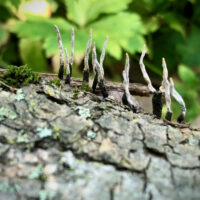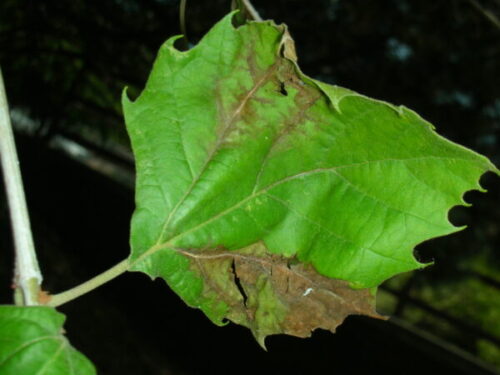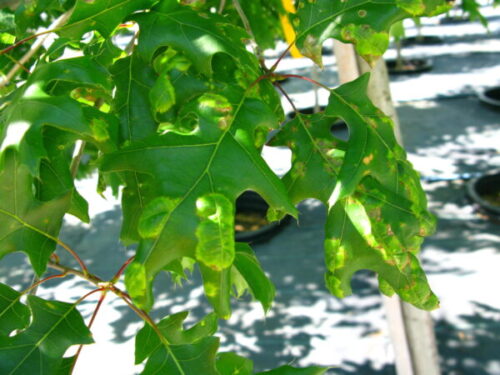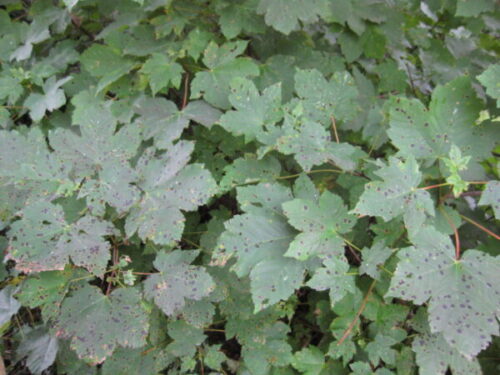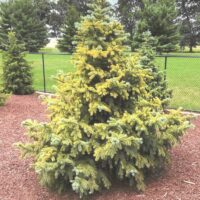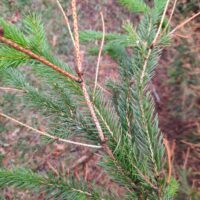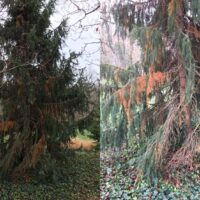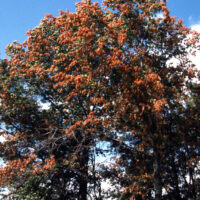 Purdue University - Extension - Forestry and Natural Resources
Purdue University - Extension - Forestry and Natural Resources
Got Nature? Blog
Purdue Landscape Report: Dead man’s fingers is an apt moniker for a gruesome-looking fungus (Xylaria polymorpha and related species) that produces club-shaped fungal fruiting bodies that appear as fingers growing around the base of dying or dead woody plants and even wooden objects in soil (Fig. 1). With more than 25 species of Xylaria, generalizations are difficult to make (Fig. 2), but we will persevere anyways, recognizing that some Xylaria species are limited to a saprophytic existence decomposing wood (like X. polymorpha) while others, like X. mali, cause an opportunistic black root rot on apple and crabapple (Rogers, 1984; Rogers and Callen, 1986) or nothing at all (Fig. 2). Other Xylaria species infect Norway maple, honey-locust, elm and pears (flowering and edible). Perhaps the scariest thing about dead man’s fingers is its taxonomy: X. polymorpha is an extremely variable and complicated species showing “multiple interfaces and intergradations with numerous other taxa” making speciation a challenge (Lee et al, 2000), which may explain why a crabapple with a bad graft union covered in dead man’s fingers looks otherwise healthy!
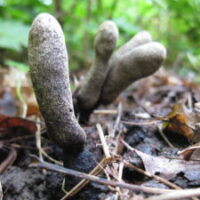
Figure 1. Dead man’s fingers is an apt moniker to describe the fruiting body of Xylaria species. Photo by Janna Beckerman.
Symptoms and Signs
Symptoms of infection by Xylaria may appear as stress and decline, including slowed growth, dieback, premature autumn coloration and leaf drop, and even crown or structural root cankers. Apple, crabapple or pear trees infected may produce an unusually large crop of undersized fruit.
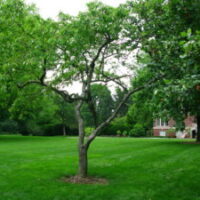
Figure 3a. Dead man’s fingers can be found associated with otherwise healthy, asymptomatic trees, or simply growing on dead wood—not necessarily causing disease.
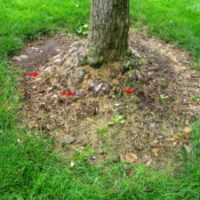
3b. Close-up of the rootstock with multiple croppings of Xylaria on the crown. Photo by Janna Beckerman.
Signs of Xylaria are more readily identified—namely, the dead man’s fingers (Fig. 4)! The club shaped, fingerlike fruiting bodies appear singularly or as clustered “fingers” about 1- 4 inches high, often at the base of infected or dying trees, or nearby large structural roots (Fig 4). In the spring, ascospores are produced by the “fingers”, creating a bluish bloom on the tips of the fingers. Cutting into a finger reveals a white interior with black bubbles that produce the sexual spores (ascospores). The “fingers” can release these spores for several months or years. In the spring, Xylaria can produce asexual spores (called conidia) anywhere on its surface, while also producing threadlike structures (called hyphae) that grow through dead or dying wood. Xylaria can survive as hyphae in roots for up to 10 years and can spread from plant to plant via hyphae when plant roots contact each other.
To view this full article and other Purdue Landscape Report articles, please visit Purdue Landscape Report
Subscribe and receive the newsletter: Purdue Landscape Report Newsletter.
Resources:
Tree Defect Identification, The Education Store
Tree wounds and healing, Got Nature? Blog
Tree Risk Management, The Education Store
Why Is My Tree Dying?, The Education Store
The Woody Plant Seed Manual, U.S. Forest Service
Native Trees of the Midwest, The Education Store
Invasive Species, Playlist, Purdue Extension – FNR YouTube Channel
Report Invasive Species, Purdue Invasive Species
Find an Arborist, International Society of Arboriculture
Subscribe Purdue Extension-Forestry and Natural Resources YouTube Channel
Janna Beckerman, Professor of Plant Pathology
Purdue Department of Botany
Purdue Landscape Report: Many trees are planted for their beautiful fall color, especially in locations where the climate provides reliable autumn weather. I have said this multiple times during extension talks and conversations with submitters to the Purdue Pest & Plant Diagnostic Lab (PPDL), but I seem to have not experienced a ‘normal’ fall since moving to Indiana with how erratic the weather has been from year to year. Depending on weather conditions, such as high heat and drought, colors may develop early or may be duller for specific varieties than expected.
However, individual trees that begin to show fall colors earlier than expected (August, September, even early October) may be shouting out a proverbial cry for help. Plants will often show yellow or red foliage coloration during periods of stress, so this may occur at any point during spring, summer, or fall. Individual trees may also show fall coloration earlier than others of their species in the same area. Now is the time to keep an eye out for this kind of early fall color as it can give you a heads-up on issues you can expect next year.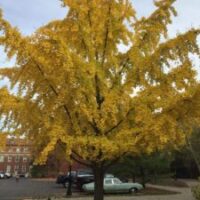
When examining a tree with early fall color, I would recommend checking the following:
- Is there a root flare?
Purdue Landscape Report: Deep Planting article- If not – tree could be planted too deep or the soil grade may have been changed
- Is there any obvious damage to the trunk, root flare, or surface roots?
- If so, there could internal decay that is not obvious and could be contributing to stress
- Are there any girdling roots?
Purdue Landscape Report: Stem Girdling Roots article- If present, they could be affecting the vascular system and strangling the tree
- Is the rootzone mulched?
- If not, the tree could be under stress from earlier drought, or weed and grass competition.
- If so, make sure it is not mounded against the trunk of the tree
- Does the soil appear compacted? Was there construction near the tree within the last 5 years?
- Compaction leads to issues with water, nutrient, and even oxygen availability to the roots and could lead to general decline
It is important to know the host species, but with the sheer volume of plant material available for sale in the nursery trade, it is even more important to know the cultivar that you are planting so you know what you might expect coming into the fall.
To view this full article and other Purdue Landscape Report articles, please visit Purdue Landscape Report.
Subscribe and receive the newsletter: Purdue Landscape Report Newsletter.
Resources:
Why Fall Color is Sometimes a Dud, Purdue Landscape Report
Forest Migration Plays a Role in Fall Foliage Colors, Purdue College of Agriculture News
U.S. Forest Service Fall Colors, Forest Service, U.S. Department of Agriculture
ID That Tree Fall Color: Sugar Maple, Purdue Extension – Forestry and Natural Resources YouTube Channel, ID That Tree Playlist
ID That Tree Fall Color Edition: Black Gum, Purdue Extension – FNR YouTube Channel, ID That Tree Playlist
Autumn Highlights Tour – South Campus, Purdue Arboretum Explorer
Why Leaves Change Color – the Physiological Basis, The Education Store, Purdue Extension resource center
Subscribe, Purdue Extension-Forestry and Natural Resources YouTube Channel
Planting Your Tree Part 1: Choosing Your Tree, Purdue Extension YouTube Channel
Summer Tree Care, Purdue Landscape Report
Tree Defect Identification, The Education Store
Tree Wound and Healing, Got Nature? Blog, Purdue Extension – Forestry and Natural Resources
Surface Root Syndrome, The Education Store
Shrubs and Woody Vines of Indiana and the Midwest, The Education Store
Ask an Expert: Tree Selection and Planting, Purdue Extension-Forestry & Natural Resources (FNR) YouTube playlist
ID That Tree, Purdue Extension-FNR YouTube playlist
John Bonkowski, Plant Disease Diagnostician
Departments of Botany & Plant Pathology
Purdue Forestry and Natural Resources’ extension efforts over the past two years amidst the COVID-19 pandemic were recognized in the Purdue Extension Specialist Quarterly newsletter.
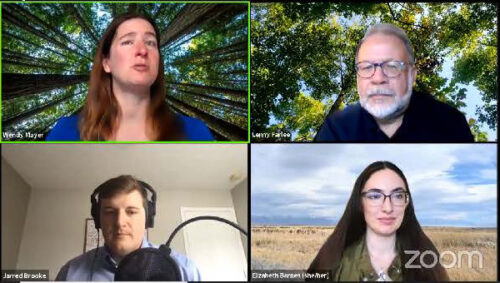 The transition to virtual content brought expertise across subject matter areas, ranging from forestry and wildlife, to aquatic sciences and entomology, to the masses in the form of several video series which collectively earned nearly 150,000 views.
The transition to virtual content brought expertise across subject matter areas, ranging from forestry and wildlife, to aquatic sciences and entomology, to the masses in the form of several video series which collectively earned nearly 150,000 views.
The FNR Extension team included: Jay Beugly, Jarred Brooke, Nick Burgmeier, Barny Dunning, Diana Evans, Lenny Farlee, Jason Hoverman, Liz Jackson, Brian MacGowan, Patrick McGovern, Wendy Mayer, Charlotte Owings, Lindsey Purcell, Bee Redfield, Shelby Royal, Bob Rode, Kara Salazar, Mike Saunders, Amy Shambach, Rod Williams, Mitch Zischke, as well as frequent Entomology contributors: Elizabeth Barnes, Cliff Sadof.
The feature in the fourth quarter newsletter begins:
“While Covid caused limitations on travel and in-person events nationwide, across Indiana, many were spending more time in outdoor recreational activities, hiking, bird-watching, hunting and fishing, or managing natural resources properties. Adjusting to the pandemic, the FNR team created an innovative and team-oriented instruction approach through skill-building in video production with coordinated connection and crosspromotion of resources.
“Forestry and Natural Resources (FNR) faculty, specialists, staff, and students, with invited partners across research and Extension, delivered 45-minute Ask an Expert Facebook Live programs for 35 weeks. Programs covered many FNR specialties: Animals & Insects (bats, bird, cicadas, coyotes, deer, fish, frogs, hellbenders, moles, pollinators, salamanders, snakes, toads, turtles, and wood pests); Plants & Ecosystems (invasive plant species, hardwood ecosystems, native grasses for wildlife, conservation tree planting, rainscaping, fall food plots, and selecting, planting and inspecting trees); and Management & Operations (prescribed fires, aquatic plant and pond management, and fish and wildlife management).
Resources:
Ask An Expert Playlist, Purdue Extension – Forestry and Natural Resources (FNR) YouTube Channel
ID That Tree Playlist, Purdue Extension – FNR YouTube Channel
A Woodland Management Moment Playlist, Purdue Extension – FNR YouTube Channel
Wildlife Habitat Hint Playlist, Purdue Extension – FNR YouTube Channel
Subscribe to the Purdue Extension – Forestry and Natural Resources YouTube Channel
Wendy Mayer, FNR Communications Coordinator
Purdue University Department of Forestry and Natural Resources
Diana Evans, Extension and Web Communication Specialist
Purdue University Department of Forestry and Natural Resources
 The interdisciplinary faculty and staff behind the Purdue Landscape Report, which provides science-based, timely information regarding Midwest landscapes to commercial growers, garden centers, landscapers, arborists and the general public, has been named as the recipient of the Purdue Agriculture TEAM Award, which was created in 1995 to recognize interdisciplinary team achievements of faculty and staff.
The interdisciplinary faculty and staff behind the Purdue Landscape Report, which provides science-based, timely information regarding Midwest landscapes to commercial growers, garden centers, landscapers, arborists and the general public, has been named as the recipient of the Purdue Agriculture TEAM Award, which was created in 1995 to recognize interdisciplinary team achievements of faculty and staff.Led by Kyle Daniel, nursery and landscape outreach specialist in the Department of Horticulture and Landscape Architecture, the Purdue Landscape Report is a collaborative effort between Purdue Extension specialists and diagnosticians in the departments of Botany and Plant Pathology, Entomology, Forestry and Natural Resources, and Horticulture and Landscape Architecture. Articles cover everything from urban forestry and tree maintenance to pest and disease problems and management to plant selection and turf science. In addition to an email newsletter and online blog, PLR staff also provide live interactive webinars in order to highlight content and respond to questions from the audience.
In response to the pandemic, the Purdue Landscape Report staff also began a live, to addresses articles and hot topics. That series garnered more than 2,000 views.
In a January 2021 survey sent to PLR subscribers, 88% of respondents said they believed that the newsletter improved their ability to diagnose a problem, while 76% said that PLR has had a positive economic impact on their business.
A local professional shared that “Sometimes when I open up the PLR, it is like you have been reading my mind. The problem I have been seeing or thinking about is there in your headlines.”
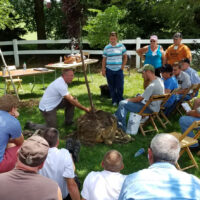 One PLR subscriber said “The Purdue Landscape Report is a great resource for myself and my team members. Within each issue is one or more topics that our team has encountered or discussed recently and the information provided by a very reputable source gives us the material needed to provide the best service to our clients and increase our knowledge base. The virtual sessions are another great resource provided that give an opportunity to have specific questions answered by experts.”
One PLR subscriber said “The Purdue Landscape Report is a great resource for myself and my team members. Within each issue is one or more topics that our team has encountered or discussed recently and the information provided by a very reputable source gives us the material needed to provide the best service to our clients and increase our knowledge base. The virtual sessions are another great resource provided that give an opportunity to have specific questions answered by experts.”
The impact extends from landowners to industry professionals and beyond.
“Often we take for granted the information produced in the PLR and we forget the countless dollars we have saved from information in the PLR,” said Rick Haggard, Indiana Nursery and Landscape Association Executive Director.
“The Purdue Landscape Report provides timely information to the Indiana Arborist Association members and associated parties in a format that is easily accessed and understood,” Associate Executive Director of IAA Ashley Mulis said. “The collaboration that goes into providing this product demonstrates the cohesive nature of several departments within Purdue University and the open sharing and comparison of information. The Purdue Landscape Report is an excellent addition to the many publications offered within Purdue Extension in helping resource professionals manage the ever-changing landscape of pests, diseases and best management practices.”
Resources:
Purdue University Department of Forestry and Natural Resources
Indiana Arborist Association
MyDNR Email Newsletter: DNR recently updated its recommendations related to the bird disease outbreak. Based on the data received from reports submitted by Indiana residents, it appears that the bird illness is consistently affecting specific areas. Find which counties are continuing to be affected by this outbreak on our website.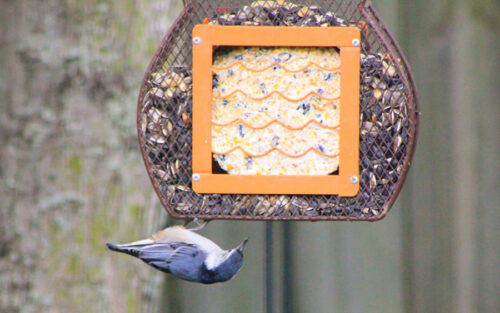
One of the simplest and most effective ways residents can help wild birds is by regularly cleaning bird feeders. Seed and suet feeders should be cleaned at least once every two weeks, and hummingbird feeders should be cleaned at least once a week. Bird feeders can be a breeding ground for disease if not properly cleaned. Help your feathered visitors stay healthy year-round by scrubbing feeders with soap and water, followed by a short soak in a 10% bleach solution.
Resources:
Cause of Songbird Deaths Remains a Mystery, Purdue Extension-Forestry and Natural Resources, Got Nature? Blog
Birdfeeder tips, The National Audubon Society
Birds and Residential Window Strikes: Tips for Prevention, The Education Store, Purdue Extension resource center
Breeding Birds and Forest Management: the Hardwood Ecosystem Experiment and the Central Hardwoods Region, The Education Store
Managing Woodlands for Birds Video, Purdue Extension-Forestry and Natural Resources YouTube Channel
Indiana Department of Natural Resources
Starting in May, the Indiana Department of Natural Resources (DNR) began to receive reports of sick and dying songbirds from several counties around the state. As of now, the cause of the illness remains a mystery although submitted specimens have tested negative for avian influenza and West Nile virus according to the DNR. Affected birds have white crust and discharge around the eyes and damage to their nervous system. Reports of sick birds have expanded to many more counties in Indiana.
Several diseases that affect songbirds are transmitted from one animal to another. Bird feeders can increase the likelihood of disease transmission by facilitating close contact among birds. Even though the disease and its mode of transmission in this case is unknown, the DNR is recommending all Hoosiers remove their birdfeeders.
 Officials recommend the following steps:
Officials recommend the following steps:
- Use the DNR sick/dead wildlife reporting tool at on.IN.gov/sickwildlife to alert DNR staff.
- Stop feeding birds until the mortality event has concluded.
- Clean feeders and baths with a 10% bleach solution.
- Avoid handling birds. If you need to handle birds, wear disposable gloves.
- When removing dead birds, wear disposable gloves and place birds and gloves in a sealable plastic bag to dispose with household trash.
- Keep pets away from sick or dead birds as a precaution.
- Proper care of bird feeders and seed is an important part of preventing disease transmission at birdfeeders.
The Audubon Society recommends the following best practices:
- Clean feeders monthly using one part bleach to nine parts warm water. Soak the feeder in the solution for a few minutes, rinse, and air dry.
- If uneaten food is accumulating in or under feeders, consider using less food or switch to a seed more to the birds’ liking.
- If birds are fighting over space at a feeder, consider adding more feeders to alleviate the congestion that can potentially be responsible for the rapid spread of disease.
- Avoid throwing large amounts of food on the ground or alternate ground feeding areas so that uneaten food does not accumulate and develop bacteria or mold.
Resources:
DNR recommends removal of birdfeeders statewide – June 25, Indiana Department of Natural Resources
Birdfeeder tips, The National Audubon Society
Birds and Residential Window Strikes: Tips for Prevention, The Education Store, Purdue Extension resource center
Breeding Birds and Forest Management: the Hardwood Ecosystem Experiment and the Central Hardwoods Region, The Education Store
Managing Woodlands for Birds Video, Purdue Extension-Forestry and Natural Resources YouTube Channel
Brian MacGowan, Wildlife Extension Specialist
Purdue University, Department of Forestry and Natural Resources
Purdue Landscape Report: While fungi are responsible for many of our foliar disease problems, different fungal pathogens present as problems throughout the country, depending upon the host plant grown and the environmental conditions. This is a brief overview of several common types of fungal leaf diseases that occur in Indiana and throughout North America (and Europe). Recognizing the symptoms and signs is an important first step to diagnose a disease problem, followed by how to manage these diseases by combining cultural and chemical controls.
Common fungal leaf diseases of deciduous trees and shrubs
Anthracnose. Anthracnose diseases probably are the best-known foliar fungal diseases of deciduous trees. They affect many ornamental trees including major shade-tree genera such as sycamore (Platanus spp.), oak (Quercus spp.), maple (Acer spp.), elm (Ulmus spp.) and ash (Fraxinus spp.) (Fig. 1). Anthracnose actually is a general term describing symptoms such as dead irregular areas that form along and between the main vein of the leaf. The leaves may also become curled and distorted and twigs may die back. The fungus overwinters in infected twigs and the petioles of fallen leaves, and the spores disseminate in the spring by wind and splashing rain. The disease, while unsightly, rarely results in the tree’s death. Sycamores and other trees often withstand many years of partial defoliation. However, one anthracnose disease is more serious. Dogwood anthracnose (Discula destructiva) is a devastating problem on the Eastern seaboard, but has not been a significant issue here in Indiana.
Leaf blisters result in the blistering, curling and puckering of leaf tissue. Oak leaf blister (Taphrina caerulescens) is a common blister disease of oaks (Fig. 2)., particularly the red oak subgenus, which includes Northern red oak (Q. rubra) and pin oak (Q. palustris) among others. The symptoms begin as a slight yellowing of the infected leaf followed by round, raised blisters. These turn brown, and the infected leaves fall prematurely. This fungus overwinters as spores on the buds.
Leaf spot is a general symptom caused by a multitude of pathogens and infect all deciduous trees and shrubs, and include dead spots with a defined boundary between living and dead tissue. The dead tissue often separates from the surrounding living tissue creating a “shot-hole” appearance on the infected leaves. Common hosts include dogwood, maples, hydrangea, rose, holly, and Indian-hawthorn.
Tar spot (Rhytisma spp.) is a leaf disease with initial symptoms similar to leaf spot. The disease is most common on red (Acer rubrum) and silver maple (A. saccharinum) (Fig.3), but it can occur on a wide range of maple species from sugar (A. saccharum) and Norway (A. platanoides) to bigleaf maple (A. macrophyllum). The symptoms begin in the spring as small greenish-yellow spots on the upper leaf surface that, by mid-summer, progress to black tar-like spots about 0.5 inch in size. The disease is not fatal to the tree, but the appearance of the tar spots alarms some tree owners. A major outbreak in New York about 10 years ago left many maples completely defoliated by mid-August.
Resources:
Diplodia Tip Blight of Two-Needle Pines, The Education Store, Purdue Extension resource center
Boxwood Blight, The Education Store
Disease of Landscape Plants: Cedar Apple and Related Rusts on Landscape Plants, The Education Store
Planting Your Tree Part 1: Choosing Your Tree, Purdue Extension YouTube Channel
Tree Planting Part 2: Planting a Tree, Purdue Extension YouTube Channel
Purdue Landscape Report
Janna Beckerman, Professor of Plant Pathology
Purdue Department of Botany and Plant Pathology
Resources
Borers of Pines and Other Needle Bearing Evergreens in Landscapes, The Education Store, Purdue Extension resource center
Ask an Expert Question: Blue Spruce dying, what can I do?, Got Nature? Blog, Purdue Extension – Forestry and Natural Resources
Why Spruce Trees Lose Their Needles, Purdue Extension
Diseases Common in Blue Spruce, Purdue Extension
John Bonkowski, Plant Disease Diagnostician
Purdue Department of Botany and Plant Pathology
Purdue Landscape Report: When the irises begin to bloom, expect up to 1.5 million cicadas per acre to begin boiling out of the ground. This spring Indiana will see the emergence of the 17-year cicadas (Brood X). These insects feed underground for most of their lives drinking sap from tree roots. Once every 17 years they emerge en masse, climb up trees, sing (though it sounds more like screaming), mate, and lay their eggs on the tips of tree branches. This cycle is completely natural and has a long history in written and oral records. Cicadas are not harmful to humans, provide a feast for wildlife, and mostly only cause cosmetic injury to trees. However, there are some trees that will need protection to survive.
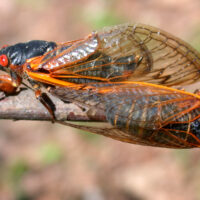
17-year cicadas have much brighter colors than their annual cousins. They can be recognized by their bright red eyes, black bodies, and orange wing veins. Image by John Obermeyer, Purdue Entomology, Purdue University.
Cicada Emergence Timing and Locations
Where can you find cicadas?
17-year cicadas can be found throughout Indiana but the biggest populations will be in southern Indiana. According to Cicada Mania, these cicadas were reported to be more abundant in the following areas during their last emergence in 2004: “Bloomington, Brookville, Clinton Falls, Dillsboro, Fishers, French Lick, Indianapolis, Lawrenceburg, Lexington, Martinsville, McCormick’s Creek State Park, Nashville, North Vernon, Skiles Test Park, Spencer”
What do cicadas look like?
Cicadas tend to have sturdy, thick bodies with mostly clear wings that are longer than their bodies. 17-year cicadas are distinctive from the annual cicadas in that their bodies are a dark, nearly black brown with amber highlights on their wing veins, and red eyes (figure 1). Check out this video to see the full life cycle and hear what a chorus of cicadas sounds like!
How many species of cicadas are there in Indiana?
There are more than you’d think! There are three main species of 17-year cicada in Indiana and about 16 species of annual and 13-year cicadas. You can find a full list here.
Cicada Damage and Control
What do cicadas prefer to eat?
17-year cicadas aren’t picky! They’ll feed on more than 270 species of woody plants. They show a slight preference for deciduous trees like maple, fruit trees, oak, and dogwood, but will generally feed on any deciduous tree or bush available to them.
How do cicadas injure plants?
Cicadas lay eggs by stabbing their ovipositor into tree bark. This can create scars in the bark. If enough cicadas lay eggs on a small branch, it can kill the twig. As a result, large trees sometimes have minor dieback at the ends of branches but overall tree health isn’t affected (figure 2). Small or young trees and shrubs, however, may be more seriously harmed.
What kind of plants should be protected from cicadas?
Cicada females prefer to lay their eggs in branches that are about 3/16 to 1/2 inch in diameter. Therefore, young deciduous trees or bushes that have major branches less than ½ inches in diameter should be protected in areas with high numbers of cicadas emerging. Mature trees do not require protection.
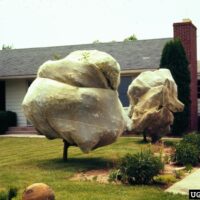
All vulnerable parts of trees should be completely covered. Note how the branches are fully covered by the fine netting and the fabric is tied tightly at the trunk of the tree. Photo by James B Hanson USDA Forest Service.
How should I protect my trees from cicadas?
Homeowners:
Homeowners only need to worry if they have newly planted trees (3-4 years old). The best way to protect these young trees is to cover them in a mesh fabric for the ~1 month period when the cicadas are active in the area. The mesh bags can be made from a variety of materials as long as the holes are smaller than 1 cm (~3/8 inch). Drape the fabric over all the twigs and branches that are smaller than 3/8 inches and secure it at the bottom so that cicadas cannot climb up from underneath (figure 3). The goal is to prevent the cicadas from having access to the branches so that they will lay their eggs elsewhere.
The best way to keep up to date about this spring’s cicada emergence is to either sign up for our Cicada Newsletter or follow Purdue Entomology on Twitter or Facebook. We will share updates about the emergence timeline, any updates to management recommendations, community science programs, crafts for kids, and more. If you have any questions, please feel free to reach out to the authors!
Billions of Cicadas Are Coming This Spring; What Does That Mean for Wildlife?, Got Nature? Blog, Purdue Extension-Forestry and Natural Resources (FNR)
17 Ways to Make the Most of the 17-year Cicada Emergence, Purdue College of Agriculture
Ask an Expert: Cicada Emergence Video, Got Nature? Blog, Purdue Extension-FNR
Periodical Cicada in Indiana, The Education Store, Purdue Extension resource center
Cicada Killers, The Education Store
Purdue University Department of Entomology
Purdue University Department of Entomology
 Well-maintained trees provide many benefits including increased property values, improved air quality and curb appeal. Trees are living organisms making them vulnerable to pests and environmental extremes resulting in health issues which result in defects. This publication will help guide you on where and how to identify tree defects and a better understanding of when to contact an arborist for assistance.
Well-maintained trees provide many benefits including increased property values, improved air quality and curb appeal. Trees are living organisms making them vulnerable to pests and environmental extremes resulting in health issues which result in defects. This publication will help guide you on where and how to identify tree defects and a better understanding of when to contact an arborist for assistance.
Resources
Tree wounds and healing, Got Nature? Blog, Purdue Extension – Forestry and Natural Resources
How to Identify Tree Defects and What to Do About It?, Got Nature? Blog
Iron Chlorosis of Trees and Shrubs, The Education Store, Purdue Extension resource center
Surface Root Syndrome, The Education store
Tree Appraisal and the Value of Trees, The Education Store
Lindsey Purcell, Urban Forestry Specialist
Purdue University, Department of Forestry and Natural Resources
Recent Posts
- IN DNR Deer Updates – Epizootic Hemorrhagic Disease Detected in Several Areas in Indiana
Posted: October 16, 2024 in Alert, Disease, Forestry, How To, Wildlife, Woodlands - The Summer of Triclopyr – Purdue Landscape Report
Posted: August 21, 2024 in Disease, Forestry, Forests and Street Trees, Invasive Plant Species, Urban Forestry, Wildlife - Septorioides Needle Blight of Pine – Purdue Landscape Report
Posted: July 31, 2024 in Disease, Forestry, Plants, Wildlife - Wild Deer in Chronic Wasting Disease Positive Areas – MyDNR
Posted: July 29, 2024 in Disease, Forestry, Urban Forestry, Wildlife - Case Study: Maple Tree Pests – Purdue Landscape Report
Posted: June 26, 2024 in Disease, Forests and Street Trees, Plants, Spiders, Urban Forestry, Wildlife, Woodlands - MyDNR – First positive case of chronic wasting disease in Indiana
Posted: April 29, 2024 in Alert, Disease, How To, Safety, Wildlife - Declining Pines of the White Variety – Purdue Landscape Report
Posted: April 10, 2024 in Alert, Disease, Forestry, Plants, Wildlife, Woodlands - Help Research Chronic Wasting Disease – Wild Bulletin
Posted: April 3, 2024 in Disease, Forestry, How To, Safety, Wildlife, Woodlands - Learn About Lead: Avoiding Lead Ingestion in Wild Game, Wild Bulletin
Posted: December 8, 2023 in Alert, Disease, How To, Safety, Wildlife - Inonotus Dryadeus, Butt and Root Rot of Oaks-Purdue Landscape Report
Posted: October 30, 2023 in Alert, Disease, Forestry, Plants, Wildlife, Woodlands
Archives
Categories
- Alert
- Aquaculture/Fish
- Aquatic/Aquaculture Resources
- Ask the Expert
- Christmas Trees
- Community Development
- Disease
- Drought
- Forestry
- Forests and Street Trees
- Gardening
- Got Nature for Kids
- Great Lakes
- How To
- Invasive Animal Species
- Invasive Insects
- Invasive Plant Species
- Land Use
- Natural Resource Planning
- Nature of Teaching
- Plants
- Podcasts
- Ponds
- Publication
- Safety
- Spiders
- Timber Marketing
- Uncategorized
- Urban Forestry
- Webinar
- Wildlife
- Wood Products/Manufacturing
- Woodland Management Moment
- Woodlands
